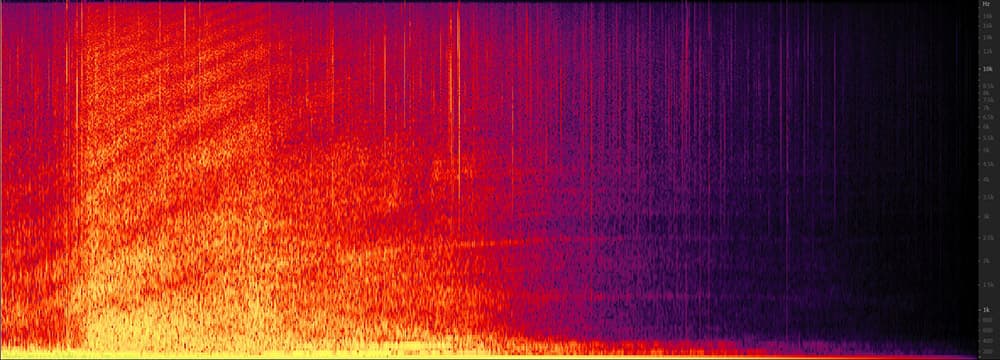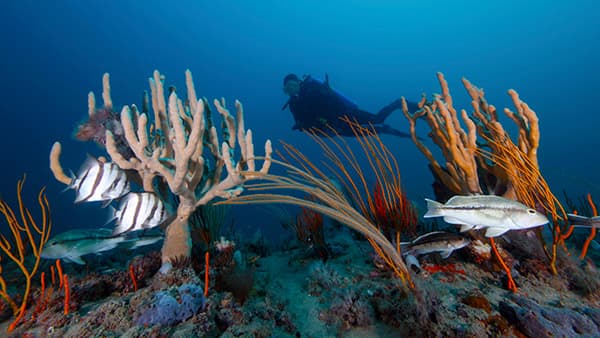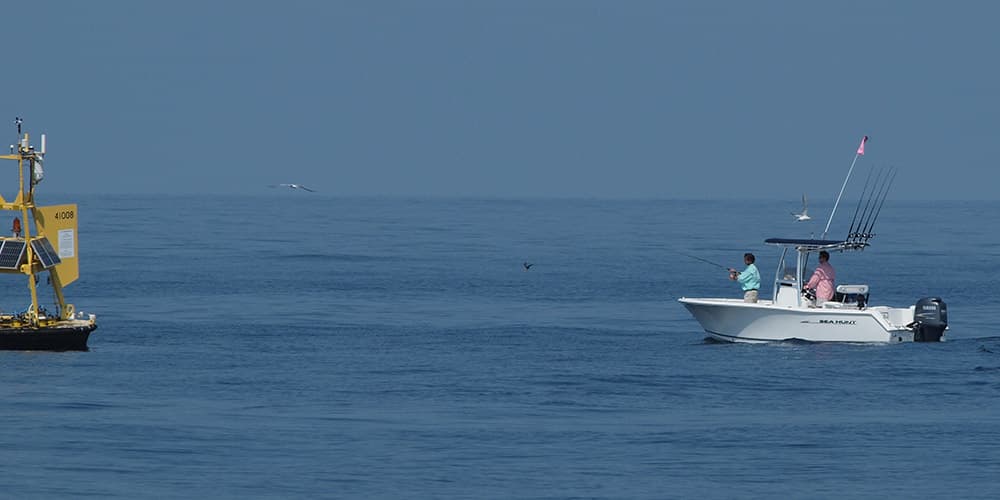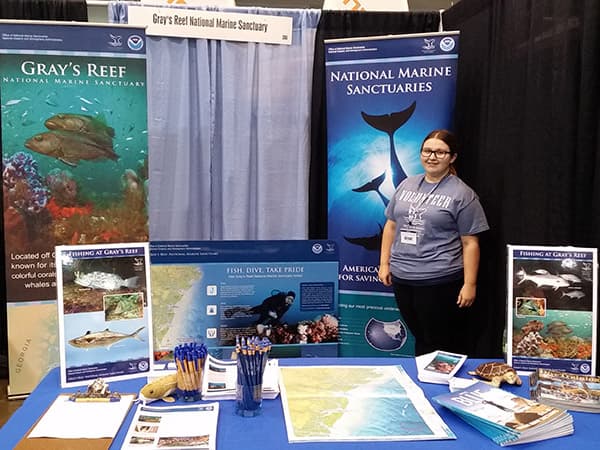Estimating Fishing and Diving Use at Gray's Reef by Listening to Boats
April 2021
By Michelle Riley

Avid anglers like to head offshore to Gray's Reef National Marine Sanctuary, a hot spot for reeling in large fish. Likewise, recreational divers regularly explore the nooks and crannies of Gray's Reef, which protects a 22-square-mile area of the Atlantic Ocean that is teeming with marine life. As a place for ocean studies, the designated research-only area of the sanctuary attracts scientists from far and wide.
So, is Gray's Reef National Marine Sanctuary crowded with divers, fishers, and scientists? Is the level of visitation stressing the marine life and the pristine habitat? How many boats are in Gray's Reef on a given day, and why does it matter?
Acoustic Monitoring at Gray's Reef
To answer those questions and more, we're using sound to estimate visitation at Gray's Reef. Situated 19 miles due east of Sapelo Island, Georgia, the sanctuary can only be accessed by boat. As part of SanctSound, a project co-led by NOAA and the U.S. Navy, our science divers have deployed stationary recorders, known as hydrophones, on the ocean floor in three locations within Gray's Reef.
Using special software algorithms, scientists analyze the recordings and are able to document the number, duration, and behaviors of boats detected by the sound they produce at the three different locations. This process of recording and analyzing underwater sounds using hydrophones and other technologies is called passive acoustic monitoring.

In order to see sound, researchers use spectrograms 一 seen here 一 to compare the frequency and loudness of a recording.
"Gray's Reef National Marine Sanctuary serves a lot of different functions as one of America's underwater parks," says Stan Rogers, superintendent of Gray's Reef. "It's important that we understand how often humans visit Gray's Reef and whether they are using the sanctuary for entertainment or for science. We want to ensure that Gray's Reef remains a great place to fish and dive recreationally, while also serving as a living laboratory for scientists. Equally important is Gray's Reef's ecological health. We must conserve the vibrant live-bottom habitat that is highly productive for marine life to live, rest, forage for food, mate and have babies, or use as a migration corridor."


Our Findings
We've analyzed the sound data for calendar year 2019, which is compiled in a technical memo (pp. 16-25) and a story map prepared by NOAA's National Center for Coastal Ocean Science (NCCOS). We estimate that visitation to Gray's Reef is relatively low, meaning that on any given day, there might be only four or five people at the sanctuary. Standardized comparisons among sites are helpful to sanctuary managers tasked with continually assessing the effectiveness of site-specific management practices and underscore that Gray's Reef is a special place for listening. The hard sandstone ledges create a vibrant habitat that not only is abundant with fish, but also attracts sea turtles. Additionally, more than 900 different species of invertebrates like crabs, sea stars, and octopuses use Gray's Reef, and it is part of the calving habitat of the highly endangered North Atlantic right whale.

The scientists summarized daily and seasonal visitation patterns, visitation differences between the three hydrophone locations, and inferred activity. Data indicated fewer than 500 vessel visits to Gray's Reef in 2019, excluding research vessels or ships transiting outside the sanctuary. The highest number of visits occurred on weekends during the daytime in the summer, from 9 a.m. to 1 p.m. 一 information that will not surprise sport fishers who participate in summertime kingfish tournaments on weekends!
Applying What We Have Learned
Knowing the level of visitor use of Gray's Reef National Marine Sanctuary helps resource managers, like superintendent Stan Rogers, make informed management decisions that keep the sanctuary's fisheries thriving and sustainable. This information also helps stakeholders such as sport fishing charter boat captains, citizen scientist groups, diving clubs, conservationists, and recreational anglers decide when it is best to visit Gray's Reef and how often. Knowing who is using the sanctuary might influence fishers, divers, and other members of the public to become more involved with sanctuary management issues by volunteering on the Sanctuary Advisory Council, on various sanctuary working groups, through citizen science projects, and by generally helping Gray's Reef staff raise awareness of the importance of the sanctuary. The analysis also underscores the fact that Gray's Reef is a great place for scientists to conduct research and monitoring. By providing scientific expertise, research vessels, and other support, Gray's Reef is positioned as a catalyst for scientific research across the South Atlantic Bight and Carolinian Ecoregion in this part of the Atlantic Ocean.


Stay tuned for more news from SanctSound. Our acoustic monitoring efforts also include listening to animals at Gray's Reef, and we can't wait to wait to hear what they have to say!

